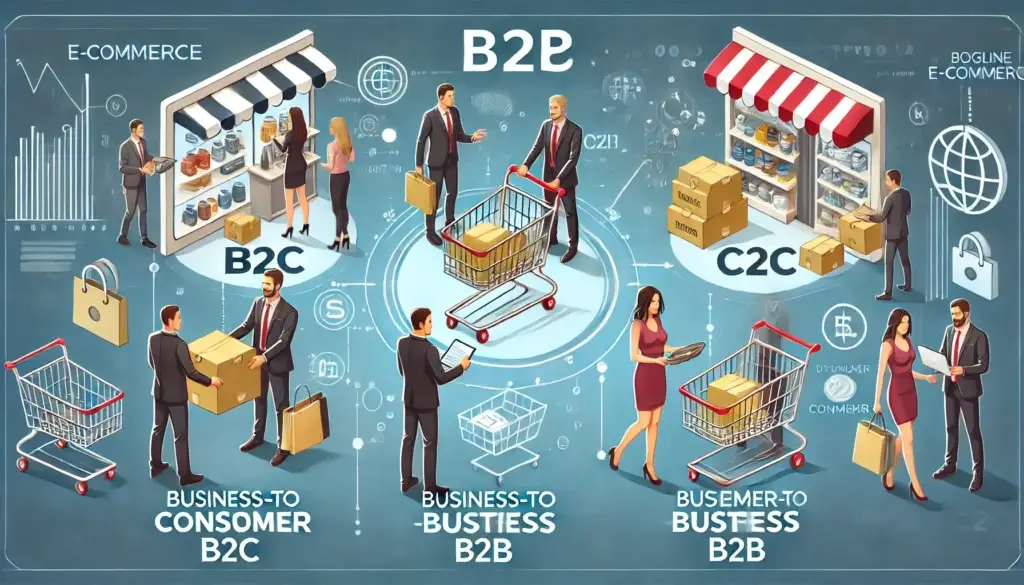What Are the 3 Types of E-Commerce?
Understanding E-Commerce and Its Various Types
E-commerce has revolutionized the way businesses operate by allowing transactions to take place online. With the rise of the internet, companies have expanded their reach, connecting with customers worldwide. The digital marketplace has created numerous opportunities for businesses, making online shopping more convenient and accessible.There are three primary types of e-commerce, each catering to different markets and business models. Understanding these types helps businesses optimize their strategies to attract the right audience and improve their sales.

Business-to-Consumer (B2C) E-Commerce
Definition and Importance
Business-to-Consumer (B2C) e-commerce is the most common type, where businesses sell products or services directly to consumers. This model is widely used in online retail stores, where individuals purchase goods for personal use. It has transformed the traditional shopping experience, offering convenience, variety, and competitive pricing.
How B2C Works
B2C transactions take place through online platforms such as e-commerce websites and mobile apps. Customers browse through product listings, add items to their shopping carts, and complete purchases using digital payment methods. Companies like Amazon, Walmart, and eBay are prime examples of successful B2C e-commerce businesses.
Benefits of B2C E-Commerce
B2C e-commerce offers numerous advantages, including a vast customer base, increased sales opportunities, and streamlined purchasing processes. With effective marketing strategies such as SEO optimization, social media advertising, and email campaigns, businesses can attract more customers and increase brand loyalty.
Business-to-Business (B2B) E-Commerce
What Is B2B E-Commerce?
Business-to-Business (B2B) e-commerce involves transactions between companies. Unlike B2C, which targets individual consumers, B2B focuses on selling products or services to other businesses. These transactions often occur in bulk, making them more complex and requiring a longer sales cycle.

How B2B E-Commerce Works
B2B e-commerce platforms facilitate trade between wholesalers, manufacturers, and retailers. Businesses use these platforms to procure raw materials, supplies, or finished products necessary for their operations. Alibaba and Shopify Plus are prominent examples of B2B marketplaces that connect businesses globally.
Advantages of B2B E-Commerce
B2B e-commerce enhances efficiency, reduces operational costs, and improves supply chain management. By automating transactions and using digital procurement systems, businesses can streamline their operations, leading to increased productivity and higher profit margins.
Consumer-to-Consumer (C2C) E-Commerce
Understanding C2C E-Commerce
Consumer-to-Consumer (C2C) e-commerce enables individuals to buy and sell products or services directly to one another. This model has gained popularity with the rise of online marketplaces and peer-to-peer platforms. It allows users to engage in commerce without intermediaries, fostering a dynamic marketplace.
How C2C Transactions Work
C2C transactions take place on platforms that facilitate direct selling and buying between individuals. Websites like eBay, Craigslist, and Facebook Marketplace provide spaces where consumers can list items for sale, negotiate prices, and complete transactions securely.
Benefits of C2C E-Commerce
C2C e-commerce promotes affordability and sustainability by allowing people to buy second-hand goods at lower prices. It also creates opportunities for individuals to generate income by selling unused or handmade items. However, trust and security remain critical factors in this model, as transactions rely on user credibility and platform policies.
Conclusion
E-commerce has evolved into a dominant force in the digital economy, with Business-to-Consumer (B2C), Business-to-Business (B2B), and Consumer-to-Consumer (C2C) being the three primary models. Each type serves a specific purpose, catering to different market needs and customer preferences.Understanding these models helps businesses refine their strategies, improve customer engagement, and maximize profitability. As technology advances, the e-commerce landscape will continue to grow, offering even more opportunities for businesses and consumers alike.